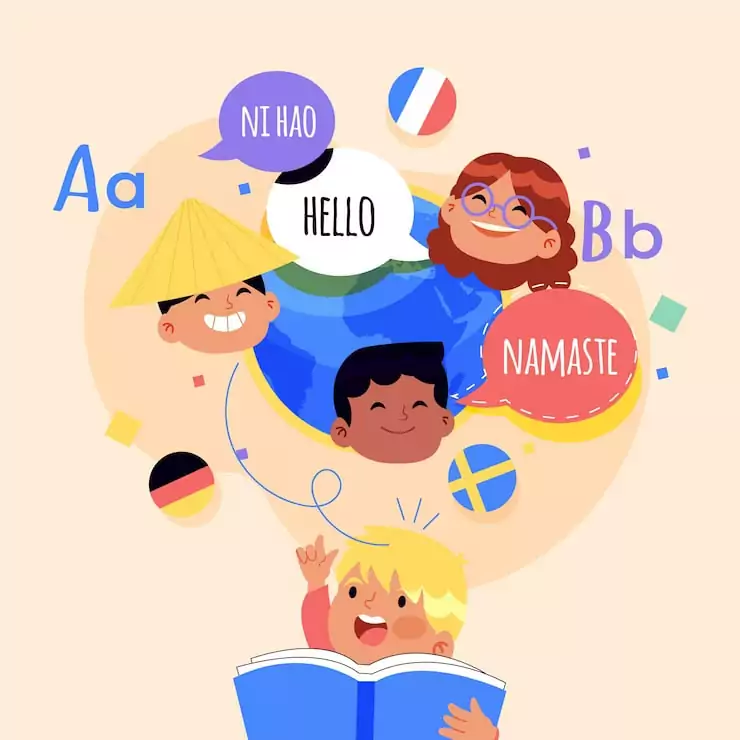Many believe that fluency in a new language requires living among its native speakers. However, this idea, often seen as a shortcut to mastery, isn’t always effective or accessible for everyone. It can be particularly daunting for beginners, potentially deterring them from starting their language learning journey, while it might motivate intermediate learners to seek out these immersive experiences.

✅ AI Essay Writer ✅ AI Detector ✅ Plagchecker ✅ Paraphraser
✅ Summarizer ✅ Citation Generator
Key Takeaways:
- Leverage online resources like streaming services, YouTube, and podcasts for a comprehensive language learning experience from home.
- Participate in online language learning groups and interactive platforms for practical conversation practice and cultural exposure.
- Combine digital language learning apps for basics with everyday practical methods, like labeling household items and learning new words daily, to build language proficiency effectively.
In the ever-evolving world of language learning, the journey of self-taught learners, especially those outside immersive environments, sparks intriguing discussions. On Reddit, a community dedicated to language enthusiasts, a burning question has surfaced: “How can one effectively learn a new language like German, particularly for native English speakers, without immersion?” Let’s find out resources and effective strategies that have proven successful.
Embracing Digital Resources in Language Learning
The journey of language learning has transformed dramatically with the advent of digital resources. Gone are the days when textbooks and classroom sessions were the only means to acquire a new language. Today, learners have a plethora of options at their fingertips, thanks to the internet. This revolution in language learning methods has opened up new, more accessible, and often more engaging ways to learn languages. From streaming media to interactive platforms, the digital age offers a golden opportunity for language learners to immerse themselves in their target language (TL) without leaving their homes.
Consuming Media and Engaging with Content
One seasoned learner on Reddit highly recommended approach is to consume media available on the internet. The abundance of free content, especially in major languages, is staggering. A learner of Italian, for instance, can find an overwhelming amount of media online, from YouTube videos to podcasts, that could last multiple lifetimes. While some high-value content might have geographical restrictions, there’s still a wealth of material that is easily accessible.
“I suggest consuming media on the internet. This is a golden age of being able to have nearly unlimited free access to more media in a major TL than ever before. In my TL Italian there is more available free online that I could consume in 3 consecutive lifespans.”
For many, YouTube is the go-to platform. It offers a diverse range of content, from educational channels to entertainment, all of which can be instrumental in language learning. The platform’s vast library allows learners to choose content that aligns with their interests, making the learning process more enjoyable and less of a chore.
“There is SO MUCH online – it’s hard to know where to start. I always go to Youtube.”
Interactive and Social Learning
Platforms like italki offer weekly conversations and lessons, providing a more interactive learning experience. This method, combined with listening to music and reading books, can greatly enhance language skills. For those who are daring, participating in social media conversations in the target language is another effective strategy. Despite the fear of making mistakes, these interactions can lead to more memorable and lasting learning experiences.
“Weekly conversations and lessons on italki. I combine those chats with tons of music and some books.”
Children’s books, comic books, and cartoons, especially those that play on words and jokes, are excellent resources. They offer a more natural learning experience outside of complete immersion. These materials are not only entertaining but also provide a gentle introduction to the language, making it less likely for learners to experience burnout.
“I like children’s books too and comic books or graphic novels. I was very happy when I started to get the jokes in cartoons (Pera toons in Italian, especially) that focused on word plays.”
“Cartoons and children books are good supplements too. Those methods are more “natural” outside actually immersion. It doesn’t feels like a chore and less likely to burn you out unless one has an interest in studying.”
Combining Digital Tools and Structured Learning
For those starting from scratch, tools like Duolingo can lay a foundational understanding of the language. However, advancing from basic recognition of words to practical application often requires more intensive resources. Channels like Easy German, combined with dedicated listening practices and grammar exercises, can elevate a learner from basic to intermediate levels. Paid memberships on such platforms can further motivate learners with structured exercises and community support.
To advance in speaking and writing, structured lessons are indispensable. A learner might require around 40 lessons to progress from elementary to intermediate levels in these skills. These lessons can be focused on specific aspects such as pronunciation, grammar, or conversational skills. The combination of various learning methods and consistent practice can lead to a comfortable proficiency level, sufficient for everyday interactions and travel.
How to Create an Immersive Language Learning Experience
Language immersion is a powerful and effective method of learning a new language. It’s more than just taking classes or memorizing vocabulary; it’s about surrounding yourself with the language in every aspect of your life. This approach helps you learn the language naturally, the way native speakers do, by engaging with the language in a variety of contexts. When you immerse yourself in a language, you’re not only learning how to speak it, but also understanding the culture and nuances that come with it. This comprehensive method can be particularly challenging, yet incredibly rewarding.

1. Listen to Music, Radio, and Podcasts
One of the simplest and most enjoyable ways to immerse yourself in a new language is through music, radio, and podcasts. This method of learning is both passive and active. Passively, you can have music or radio in the background while doing other tasks, allowing your brain to pick up on rhythms, intonations, and common phrases. Actively, you can listen to podcasts or music lyrics, trying to understand and translate them. This not only improves your listening skills but also introduces you to cultural aspects and idiomatic expressions.
Services like Spotify and YouTube are treasure troves for discovering content in your target language. You can find playlists, radio stations, and podcasts specifically designed for language learners, or simply enjoy native content that appeals to your interests. The key here is regular exposure, as the more you listen, the more you’ll understand and absorb the language’s nuances.
2. E-Meet People, Practice, and Have Fun
Learning a language at home doesn’t have to be a solitary endeavor. Joining online language learning communities and finding conversation partners are excellent ways to practice. These platforms provide an opportunity to engage in facilitated bilingual conversations, helping you to practice both listening and speaking skills. It’s a chance to interact with native speakers and learners from around the world, offering a diverse range of accents, dialects, and cultural insights.
These communities often host virtual meetups, language exchange sessions, and group discussions, allowing you to immerse yourself in real conversations. This not only enhances your language skills but also helps in understanding cultural contexts, colloquialisms, and slang. Regular interaction with native speakers and fellow learners keeps the learning process fun and engaging, and helps in building confidence in using the language.
3. Learn Five New Words Everyday
Expanding your vocabulary is a fundamental part of language learning, and setting a goal to learn five new words daily is a manageable and effective strategy. This method ensures a steady addition to your vocabulary without overwhelming you. Using a dictionary or digital tools like Vocabulary.com, you can discover new words, understand their meanings, and see them used in context.
The key to this method is not just memorization but also application. Try to use these new words in sentences throughout the day, whether in writing or speaking. This practice helps in cementing the words in your memory and understanding their practical usage. Online resources often provide interactive activities and quizzes, making the learning process more dynamic and engaging.
4. Get a Label Maker or Post-It Notes
A creative and interactive way to immerse yourself in a new language at home is by using labels or Post-It notes. This method turns your living space into a learning environment. By labeling objects around your house in the target language, you create constant visual reminders and learning opportunities. It’s a practical way to learn everyday vocabulary relevant to your life and surroundings.
Labeling goes beyond just naming objects; you can include phrases, descriptions, or even short sentences. For example, instead of just labeling a mirror as “mirror,” you could add a positive affirmation in the target language. This not only teaches you new words but also phrases and sentence structures. The process of creating these labels can be a fun and artistic activity, adding a colorful and educational aspect to your home decor.
The Verdict
Immersion language learning at home is a multifaceted approach that combines listening, speaking, reading, and writing in the target language. It’s about creating an environment where the language is a constant part of your life, allowing for natural and organic learning. Remember, language learning is a marathon, not a sprint; it requires time, patience, and continuous effort. With these methods, you can turn your home into a dynamic language learning environment, making the journey both enjoyable and fruitful.
Related
Follow us on Reddit for more insights and updates.





Comments (0)
Welcome to A*Help comments!
We’re all about debate and discussion at A*Help.
We value the diverse opinions of users, so you may find points of view that you don’t agree with. And that’s cool. However, there are certain things we’re not OK with: attempts to manipulate our data in any way, for example, or the posting of discriminative, offensive, hateful, or disparaging material.